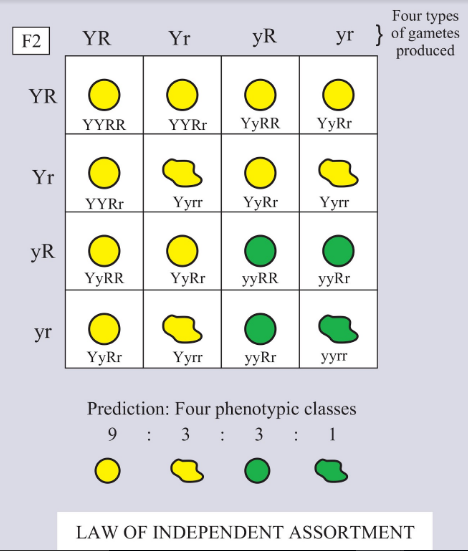
Explain the law of independent assortment with a suitable example.
Answer
450.3k+ views
Hint: Law of independent assortment is a part of Mendel’s law of inheritance which explains the inheritance of genes with two different traits from parents to the offspring. It is the third law of inheritance.
Complete answer:
Gregor Mendel, well known for his study in genetics, was a monk who was interested in farming. He studied most of the Laws of inheritance in garden pea plants (Pisum sativum). Mendel’s law of inheritance states the manner in which traits are acquired from one generation to another. How these traits are transferred, whether they have any effects on other traits or even if they are transferred whether it will be expressed or silenced. The first law of heredity postulated by Mendel was the “Law of Segregation”. Based on this law Mendel then postulated the “Law of Independent Assortment”.
The Law of independent assortment defines the independent inheritance of genes and their alleles irrespective of the other trait genes or their alleles. This was studied by Gregor Mendel in a dihybrid cross (crossing over of two plants with two distinguishable traits/features) in pea plant (traits studied: round and yellow seed). The results showed a different combination of a trait in the offsprings with regards to their parents (figure). The independent assortment of genes occurs during meiosis, wherein each haploid cell contains a mixture of genes from both the parents. The Law of independent assortment also defines the process of recombination. Recombination also occurs during meiosis where DNA undergoes crossing over to form a new combination of genes. Since the DNA from both parents undergo crossing over, the genes are sorted independent of their origin (parental origin) and independent of one another. And thus the offspring can have traits similar to either of the parents or a combination of both the parents.

Figure: Dihybrid cross showing Law of independent assortment
Example: Taking the example of a dihybrid cross in a pea plant with two distinguishable features like round and yellow seeds. The round and yellow character of a pod is a dominant trait, presented as RR (round pods) and YY (yellow pods). When this pea plant with round and yellow pods is crossed with a pea plant having green (rr) and wrinkled (yy) pods (RRYY X rryy). All the offspring in the first generation (
Note:
Mendelian work was discovered independently by three scientists-Hugo de Vries, Carl Correns, and Tshermak. Advancements made in microscopy helped them to observe the mechanism of cell division at various stages. This also led to the discovery of chromosomes.
Complete answer:
Gregor Mendel, well known for his study in genetics, was a monk who was interested in farming. He studied most of the Laws of inheritance in garden pea plants (Pisum sativum). Mendel’s law of inheritance states the manner in which traits are acquired from one generation to another. How these traits are transferred, whether they have any effects on other traits or even if they are transferred whether it will be expressed or silenced. The first law of heredity postulated by Mendel was the “Law of Segregation”. Based on this law Mendel then postulated the “Law of Independent Assortment”.
The Law of independent assortment defines the independent inheritance of genes and their alleles irrespective of the other trait genes or their alleles. This was studied by Gregor Mendel in a dihybrid cross (crossing over of two plants with two distinguishable traits/features) in pea plant (traits studied: round and yellow seed). The results showed a different combination of a trait in the offsprings with regards to their parents (figure). The independent assortment of genes occurs during meiosis, wherein each haploid cell contains a mixture of genes from both the parents. The Law of independent assortment also defines the process of recombination. Recombination also occurs during meiosis where DNA undergoes crossing over to form a new combination of genes. Since the DNA from both parents undergo crossing over, the genes are sorted independent of their origin (parental origin) and independent of one another. And thus the offspring can have traits similar to either of the parents or a combination of both the parents.

Figure: Dihybrid cross showing Law of independent assortment
Example: Taking the example of a dihybrid cross in a pea plant with two distinguishable features like round and yellow seeds. The round and yellow character of a pod is a dominant trait, presented as RR (round pods) and YY (yellow pods). When this pea plant with round and yellow pods is crossed with a pea plant having green (rr) and wrinkled (yy) pods (RRYY X rryy). All the offspring in the first generation (
Note:
Mendelian work was discovered independently by three scientists-Hugo de Vries, Carl Correns, and Tshermak. Advancements made in microscopy helped them to observe the mechanism of cell division at various stages. This also led to the discovery of chromosomes.
Recently Updated Pages
Master Class 12 Business Studies: Engaging Questions & Answers for Success

Master Class 12 English: Engaging Questions & Answers for Success

Master Class 12 Social Science: Engaging Questions & Answers for Success

Master Class 12 Chemistry: Engaging Questions & Answers for Success

Class 12 Question and Answer - Your Ultimate Solutions Guide

Master Class 11 Business Studies: Engaging Questions & Answers for Success

Trending doubts
Draw a labelled sketch of the human eye class 12 physics CBSE

a Tabulate the differences in the characteristics of class 12 chemistry CBSE

Which one of the following is a true fish A Jellyfish class 12 biology CBSE

Why is the cell called the structural and functional class 12 biology CBSE

Differentiate between homogeneous and heterogeneous class 12 chemistry CBSE

Write the difference between solid liquid and gas class 12 chemistry CBSE




